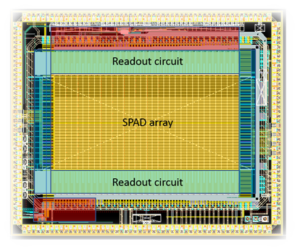Our targets include two parts, one regarding the control circuits design for imaging array employing single-photon avalanche diodes (SPADs), the other one regarding the design technology of the proposed frequency-hopping pulsed LiDAR. The key to enable a large increase in dynamic range for SPAD is to reduce the deadtime significantly. For this reason, we propose a novel gated-reset scheme requiring only a single transistor with modulated on-resistance, hence leading to a more compact pixel design. To reduce the effect due to PVT variations, a digital excess bias calibration circuit based on our patent-granted breakdown voltage monitoring technique is also proposed. It is believed to greatly improve the system reliability. For single-point range finding application, a small-scale SPAD array named macro pixel is used to further extend the dynamic range. To assist the design optimization of macro pixel, a Matlab-based performance evaluation platform is also developed. To reduce undesirable data distortion due to afterpulsing effect and crosstalk, a modified SPAD structure employing multiple breakdown isolation for reducing the total breakdown charges is proposed. The improved SPAD has to be integrated with active quenching circuit to achieve the objective. Targeting on the realization of 3D LiDARs with operating distance beyond 200m, a 64×64 imaging sensor combined with all the techniques mentioned above will be developed and evaluated in detail. Furthermore, to increase the data processing efficiency of LiDAR operation, a synchronous-scanning readout scheme is also proposed. As to reduce the ultrahigh optical peak power required for conventional LiDAR, the frequency-hopping pulsed LiDAR is proposed. By increasing the repetition rate, the pulse energy can be significantly reduced, leading to lower system cost. Additional potential advantage is the capability to mitigate the crosstalk between multiple LiDARs by employing orthogonal frequency-hopping patterns.
